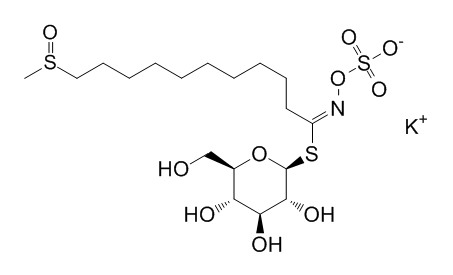GlucocamelininCAS# 67884-10-0 |

Quality Control & MSDS
Package In Stock
Number of papers citing our products

| Cas No. | 67884-10-0 | SDF | Download SDF |
| PubChem ID | N/A | Appearance | Powder |
| Formula | C18H34KNO10S3 | M.Wt | 559.8 |
| Type of Compound | Miscellaneous | Storage | Desiccate at -20°C |
| Synonyms | 10-Methylsulfinyldecylglucosinolate potassium salt | ||
| Solubility | Soluble in methanol and water | ||
| General tips | For obtaining a higher solubility , please warm the tube at 37 ℃ and shake it in the ultrasonic bath for a while.Stock solution can be stored below -20℃ for several months. We recommend that you prepare and use the solution on the same day. However, if the test schedule requires, the stock solutions can be prepared in advance, and the stock solution must be sealed and stored below -20℃. In general, the stock solution can be kept for several months. Before use, we recommend that you leave the vial at room temperature for at least an hour before opening it. |
||
| About Packaging | 1. The packaging of the product may be reversed during transportation, cause the high purity compounds to adhere to the neck or cap of the vial.Take the vail out of its packaging and shake gently until the compounds fall to the bottom of the vial. 2. For liquid products, please centrifuge at 500xg to gather the liquid to the bottom of the vial. 3. Try to avoid loss or contamination during the experiment. |
||
| Shipping Condition | Packaging according to customer requirements(5mg, 10mg, 20mg and more). Ship via FedEx, DHL, UPS, EMS or other couriers with RT, or blue ice upon request. | ||

Glucocamelinin Dilution Calculator

Glucocamelinin Molarity Calculator
| 1 mg | 5 mg | 10 mg | 20 mg | 25 mg | |
| 1 mM | 1.7864 mL | 8.9318 mL | 17.8635 mL | 35.727 mL | 44.6588 mL |
| 5 mM | 0.3573 mL | 1.7864 mL | 3.5727 mL | 7.1454 mL | 8.9318 mL |
| 10 mM | 0.1786 mL | 0.8932 mL | 1.7864 mL | 3.5727 mL | 4.4659 mL |
| 50 mM | 0.0357 mL | 0.1786 mL | 0.3573 mL | 0.7145 mL | 0.8932 mL |
| 100 mM | 0.0179 mL | 0.0893 mL | 0.1786 mL | 0.3573 mL | 0.4466 mL |
| * Note: If you are in the process of experiment, it's necessary to make the dilution ratios of the samples. The dilution data above is only for reference. Normally, it's can get a better solubility within lower of Concentrations. | |||||

Calcutta University

University of Minnesota

University of Maryland School of Medicine

University of Illinois at Chicago

The Ohio State University

University of Zurich

Harvard University

Colorado State University

Auburn University

Yale University

Worcester Polytechnic Institute

Washington State University

Stanford University

University of Leipzig

Universidade da Beira Interior

The Institute of Cancer Research

Heidelberg University

University of Amsterdam

University of Auckland

TsingHua University

The University of Michigan

Miami University

DRURY University

Jilin University

Fudan University

Wuhan University

Sun Yat-sen University

Universite de Paris

Deemed University

Auckland University

The University of Tokyo

Korea University
- Glucoraphasatin potassium salt
Catalog No.:BCN8963
CAS No.:245550-64-5
- Glucohirsutin
Catalog No.:BCN8962
CAS No.:21973-60-4
- Gluconasturtiin
Catalog No.:BCN8961
CAS No.:18425-76-8
- Sinalbin potassium salt
Catalog No.:BCN8960
CAS No.:16411-05-5
- Glucocheirolin
Catalog No.:BCN8959
CAS No.:15592-36-6
- Glucobrassicin
Catalog No.:BCN8958
CAS No.:143231-38-3
- Glucoraphasatin
Catalog No.:BCN8957
CAS No.:28463-23-2
- Noratropine
Catalog No.:BCN8955
CAS No.:16839-98-8
- Scopolamine N-oxide hydrobromide
Catalog No.:BCN8953
CAS No.:6106-81-6
- Usaramine N-oxide
Catalog No.:BCN8952
CAS No.:117020-54-9
- Lycopsamine N-oxide
Catalog No.:BCN8951
CAS No.:95462-15-0
- Echimidine N-oxide
Catalog No.:BCN8950
CAS No.:41093-89-4
- Glucoarabin
Catalog No.:BCN8965
CAS No.:67920-64-3
- 4-Methoxyglucobrassicin
Catalog No.:BCN8966
CAS No.:83327-21-3
- 4-Hydroxyglucobrassicin
Catalog No.:BCN8967
CAS No.:83327-20-2
- Epiprogoitrin
Catalog No.:BCN8968
CAS No.:21087-74-1
- Phyllalbine
Catalog No.:BCN8969
CAS No.:4540-25-4
- Glucobarbarin
Catalog No.:BCN8970
CAS No.:21087-78-5
- Glucolimnanthin
Catalog No.:BCN8971
CAS No.:111810-95-8
- Glucocapparin
Catalog No.:BCN8972
CAS No.:15592-33-3
- Sinalbin
Catalog No.:BCN8973
CAS No.:20196-67-2
- Glucobrassicanapin
Catalog No.:BCN8974
CAS No.:245550-58-7
- Glucoiberin
Catalog No.:BCN8975
CAS No.:15592-34-4
- Glucoberteroin
Catalog No.:BCN8976
CAS No.:245550-65-6
Camelina sativa defatted seed meal contains both alkyl sulfinyl glucosinolates and quercetin that synergize bioactivity.[Pubmed:25050614]
J Agric Food Chem. 2014 Aug 20;62(33):8385-91.
Camelina sativa L. Crantz is under development as a novel oilseed crop, yet bioefficacy of camelina phytochemicals is unknown. Defatted camelina seed meal contains two major aliphatic glucosinolates (GSLs), glucoarabin (9-(methylsulfinyl)nonylglucosinolate; GSL 9) and Glucocamelinin (10-(methylsulfinyl)decylglucosinolate; GSL 10), with traces of a third, 11(methylsulfinyl)undecylglucosinolate and several flavonoids, mostly quercetin glycosides. In Hepa1c1c7 cells, hydrolyzed GSLs (hGSLs) 9 and 10 upregulated the phase II detoxification enzyme quinone reductase (NQO1), with no effect on cytochrome P450 (CYP) 1A1 activity. Isobologram graphs revealed synergy of NQO1 induction for a combination of hGSL 9 and quercetin. These findings suggest that defatted camelina seed meal should be evaluated for anticancer activity, similar to broccoli and other Brassicaceae family members. Interestingly, synergy of NQO1 induction was also seen for physiologically relevant doses of sulforaphane (SF) and quercetin, two key bioactives present in broccoli. This suggests that SF within broccoli may be more potent than purified SF.


